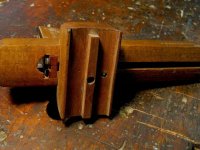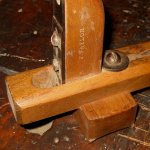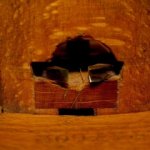It is a quirk router. If you Google "quirk router", you will find all sorts of interesting info about them, and especially about the curious cutter that first scores the sides of the groove for the inlay, and then cleans out the bottom.
I have a metal one made by Preston. Google will show you pictures of it. Tony Murland makes and sells reproduction blades for the Preston, in three widths. The business end is the same as yours, but the mounting and adjusting mechanism is a bit different, so Tony's won't work on yours.
A typical use is for cutting the groove for the purfling on the top edge of guitars, etc., but of course it can also cut a groove a fixed distance away from a straight or curved edge. Again, ask Google for examples of purfling.
The purpose of the grooves in the bottom of the fence on yours, however, puzzle me. Usually the sides of the fence are used to index the side of the work surface. I suppose the simplest explanation is that the craftsman who built your tool used a piece of scrap for the fence, but I'm open to alternate suggestions.



